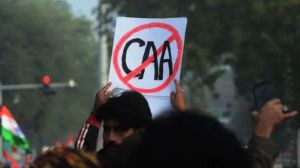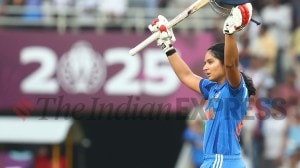Decode Politics: Why a ‘Chandigarh vision document’ stirred up old tensions in Punjab?
As Manish Tewari, AAP and Congress’s joint candidate for Chandigarh, proposed making the UT a “city-state”, both Akali Dal and BJP saw a design to “dilute” Punjab’s rights over Chandigarh
 The INDIA bloc joint candidate Manish Tewari's proposal to make Chandigarh a "city-state" has stirred a row. (Facebook/ Manish Tewari)
The INDIA bloc joint candidate Manish Tewari's proposal to make Chandigarh a "city-state" has stirred a row. (Facebook/ Manish Tewari) THE PROPOSAL of INDIA bloc’s Chandigarh candidate, Manish Tewari, that the joint Punjab and Haryana capital be made a “city-state” was one of the issues that drew fire from politicians in Punjab across party lines during the elections.
On May 20, Tewari, the sitting Congress Anandpur Sahib MP, who is fighting in Chandigarh opposite the BJP’s Sanjay Tandon, unveiled his vision document for Chandigarh, which included this proposal. A city-state model would lead to “better governance” in Chandigarh, Tiwari said.
* Why are Punjab parties opposed to this?
In its manifesto released on May 18, the Shiromani Akali Dal (SAD), which has in the past questioned Chandigarh’s continued status as a joint capital between Punjab and Haryana, said it was committed to renewing the fight for its inclusion in Punjab, along with that of other Punjabi-speaking areas that are right now in Haryana.
In the document called Ailan-Nama, the SAD said: “Chandigarh was categorically declared to belong to Punjab and was to remain a UT only for five years. We will fight the Centre’s betrayal of Punjab on this with renewed force.”
With Tewari repeatedly talking of making Chandigarh a city-state, SAD president Sukhbir Singh Badal said on May 20: “The Congress and Aam Aadmi Party’s (AAP) joint manifesto for the UT has unmasked the anti-Punjab face of both parties as they have surrendered Punjab’s right over Chandigarh by demanding state rights for the UT.”
He pointed out that under Indira Gandhi as Prime Minister, Chandigarh was to be the joint capital city of Punjab and Haryana for five years till Haryana developed its own capital.
Badal also talked in his campaign speeches about former PM Rajiv Gandhi “going back on his word” to hand over Chandigarh to Punjab on the cut-off date of January 26, 1986, as per the Rajiv-Longowal accord.
The BJP too attacked Tewari. In an interview to The Indian Express, state president Sunil Jakhar said: “Chandigarh belongs to Punjab and the state’s claim on the city is non-negotiable and indisputable… Altering the status of the UT is diluting our claim on it.”
* What exactly has Tewari proposed?
At the moment, Chandigarh is governed by the Governor of Punjab, who is Chandigarh’s administrator. The Governor is appointed by the President of India. The Administrator is assisted by an advisor of the rank of an IAS officer. Additionally, there are other administrative secretaries. The power to legislate on matters of the UT vests with Parliament. An elected Mayor heads the Chandigarh Municipal Corporation.
Throughout his campaign, Tewari called the existing governance and administrative structure of Chandigarh a “nightmare”.
In his vision document, he wrote: “It is time for Chandigarh to become a city-state. The three existing antiquated models of governance of the city, which are plagued by multiplicity of authorities and a complicated web of laws, will be consolidated into simplified and people-friendly laws supported by a legal architecture.”
In Tewari’s city-state model, Chandigarh will have a “self-governed architecture” with either a CM or a chief executive councillor. The existing municipal corporation as per him needs to be upgraded either to a Legislative Assembly or to an executive council.
* What’s the history of the conflict over Chandigarh?
After Partition, Shimla was made the temporary capital of Indian Punjab. Prime Minister Jawaharlal Nehru wanted a modern city to be Punjab’s capital, and the idea of Chandigarh was conceived.
The capital was officially moved from Shimla to Chandigarh on September 21, 1953. The Punjab Reorganisation Act of 1966 carved out the new state of Haryana from undivided Punjab and created the new Union Territory of Chandigarh under the direct control of the Centre, and transferred the hill territories of Punjab to Himachal Pradesh.
Chandigarh, identified as the capital of Punjab in The Capital of Punjab (Development and Regulation) Act, 1952, became the common capital of both Punjab and Haryana, and properties were divided between the states in the ratio 60:40.
During the reorganisation of Punjab, then PM Indira Gandhi announced that Haryana would eventually get its own capital. On January 29, 1970, the Centre said that “the capital project area of Chandigarh should, as a whole, go to Punjab”. The Indira government made this announcement after Fateh Singh, the leader of the Punjabi Suba movement, threatened self-immolation if Chandigarh was not transferred to Punjab.
On July 24, 1985, the Rajiv-Longowal Accord was signed between then Prime Minister Rajiv Gandhi and Akali leader Harchand Singh Longowal. Among other things, the Centre agreed to give Chandigarh to Punjab, and January 26, 1986, was fixed as the date for the actual transfer. However, less than a month after the signing of the accord, Longowal was assassinated by militants.



- 01
- 02
- 03
- 04
- 05




























